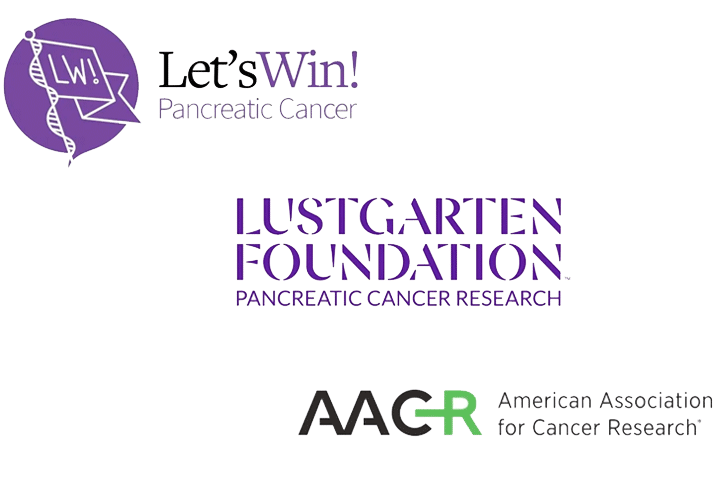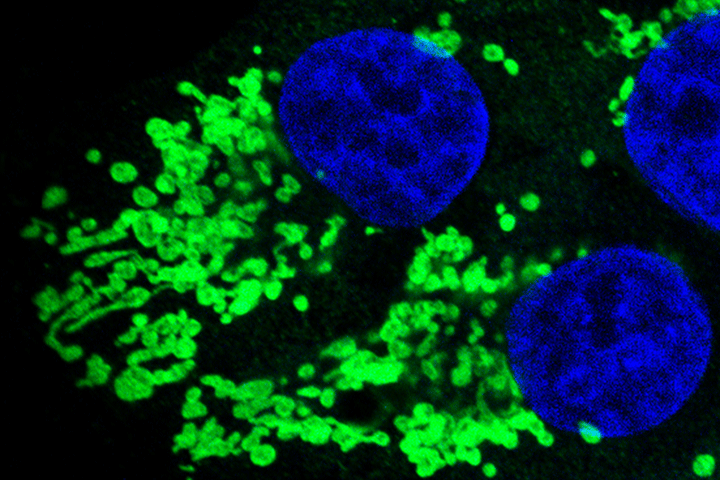AACR Virtual Special Conference on Pancreatic Cancer: Day One Highlights

Despite the difficulties of conducting scientific conferences during a pandemic, one thing was made abundantly clear. Scientists will find ways to share their knowledge among peers.
That’s certainly the case with first day presentations at the AACR Virtual Special Conference: Pancreatic Cancer. This is the seventh such conference sponsored by the AACR focused specifically on pancreatic cancer research and trials. As we have in the past, Let’s Win will be providing brief highlights of the two-day event. We will also be covering some of this innovative research in more depth during the upcoming months.
These are just a few of the highlights from today’s session. Check back tomorrow for Day Two research presentations.
Welcome to Day One
Today’s event kicked off with warm welcomes from conference co-chairs Dr. Dafna Bar-Sagi of NYU Langone Health (New York) and Dr. Brian M. Wolpin of the Dana-Farber Cancer Institute in Boston. After brief remarks they introduced lead supporters Kerri Kaplan, President and Chief Executive Officer of the Lustgarten Foundation, and Julie M. Fleshman, President and Chief Executive Officer of the Pancreatic Cancer Action Network (PanCAN).
Kaplan spoke briefly on Lustgarten’s commitment to driving research despite the pandemic, highlighting the foundation’s therapeutics-focused research program and its Translational Advisory Group, which has been very successful in bringing research to the clinical trial phase. All research is patient-centric, and as such she also highlighted a very special patient named “Art.” While being treated for pancreatic cancer with chemotherapy and a Whipple procedure, Art also contracted COVID. Today, he is doing very well due to the advances being made in better understanding pancreatic cancer.
Fleshman highlighted a significant statistic: pancreatic cancer finally hit a five-year survival milestone of 10 percent. Unfortunately, that survival statistic is still unacceptable and more needs to be done to continue to move the needle in the right direction.
Both the Lustgarten Foundation and PanCAN will continue to invest significant monies in research and patient services now and in the coming year.
Rising Star Keynote: Role of the Gut-Tumor Microbial Axis in Pancreatic Ductal Adenocarcinoma
Although most people are familiar with the so-called gut microbiome, the human microbiome is comprised of more than just our intestinal tracts. It’s actually the genetic material of all the microbes (bacteria, fungi, protozoa, and viruses), the so-called “bugs” that live on and inside the human body. Our skin has a microbiome. So do our lungs. The mouth is a hotbed of microorganisms, as is the pancreas.
Each year, the AACR highlights a young researcher’s work. This year’s Rising Star Keynote Speaker was Dr. Florencia McAllister of The University of Texas MD Anderson Cancer Center in Houston. Her work focuses on changes in gut bacteria and bacteria in pancreatic tumors, which have been associated with changes in both the immune response as well as survival in pancreatic cancer. She and her colleagues are developing mouse models to better understand the mechanisms of these changes. They are also developing an interventional clinical trial using fecal microbial transplants to understand if altering the gut microbiome can change the tumor microbiome and immune response in pancreas cancer patients.
Plenary Session 1: Tumor Microenviroment and Metastasis
Today’s first plenary session focused on the tumor microenvironment and the process of metastasis. The session chair was Dr. Ben Stanger of the Abramson Cancer Center, University of Pennsylvania. As a reader of Let’s Win, you know the tumor microenvironment presents a challenge to physician-scientists. It can cause tumors to progress quickly. It seemingly blocks the effectiveness of current drug regimens. And it alters the natural immune response in the body’s fight to recognize and then kill cancer cells. The research presented today takes varying approaches to overcoming this challenge, but one thing was made clear: Scientists today have a much better understanding of the underlying biology of pancreas cancer. This has provided them the opportunity to investigate several new avenues to potentially block growth and metastasis and increase the effectiveness of immune-based therapies.
Pancreatic cancer heterogeneity and plasticity: the mix of seed and soil: Dr. David T. Ting of Massachusetts General Hospital Cancer Center in Boston is looking to better understand the heterogeneity of the metastatic response and how a pancreas tumor’s environment influences the metastatic potential of a tumor. To do this, he is looking at so-called pancreas tumor subtypes, generally called basal-like or classical signatures, and how a tumor evolves over time, such as when it metastasizes or when certain therapies are given. He and his colleagues are beginning to map out what features of a tumor can predict how invasive it may become. The goal of the research is to potentially make earlier detection a reality and to better personalize treatment to individual patients.
ECM-dependent CAF functions in pancreatic cancer nutritional support and immunosuppression: In her lab at the Fox Chase Cancer Center in Philadelphia, Dr. Edna Cukierman is focused on understanding the 3-D interactions between the tumor and the stroma. She is specifically looking at a protein called Netrin G1 (NG1) and its ligand NGL-1. A ligand is a molecule that binds to a protein and is part of the process of signaling—or how cells talk to each other. NG1 is overexpressed in the stroma of pancreatic cancer, making tumors grow and spread. Cukierman and colleagues have found that NG1 and NGL-1 can be removed or “knocked out” (in a mouse model). This stops the tumors from growing and makes them more susceptible to starvation. The end result: the cancer dies.
Pancreatic cancer cells assemble a CXCL12-keratin 19 coating to resist immunotherapy: Dr. Douglas Fearon is trying to unravel why pancreatic cancer cells resist immunotherapy. In his presentation today, Fearon outlined how researchers are continuing to build their understanding of how pancreas tumors resist immunotherapy. For example, he and his colleagues are showing certain proteins from a pancreas tumor and its stroma form complexes that act as a kind of “stop signal” for the body’s T cells. They have been successful in blocking this signal in both mouse models and in the clinical setting. Two early-stage clinical trials have shown promise, leading to a much larger study that is ready to launch.
Plenary Session 2: Emerging Research Areas and Clinical Advances
The session chair for this session is Dr. Jennifer J. Knox of the Princess Margaret Cancer Centre in Toronto.
Heterotypic 3D bioprinted models to study pancreatic cancer: There’s no doubt new technologies are helping researchers better understand what makes pancreatic cancer tick. Dr. Ellen Langer of the Oregon Health and Science University in Portland reported on using 3-D bioprinting techniques to create tumor models in the lab. These models include multiple cell types and the complex 3-D relationships that exist in vivo. By including tumor cells, stromal cells, and endothelial cells, she and her team are creating a model that behaves more like tumors act in the body. The hope is to find new ways to regulate these interactions and halt tumor growth and spread.
Mechanisms of cellular heterogeneity in pancreatic cancer: Dr. Axel Behrens of The Francis Crick Institute, London, UK,developed a novel microscopy technique, called FLASH, that allows scientists to look at the 3-D structure of tissues, including pancreatic tumors, intact and at high resolution. Using this technique, they are already making novel discoveries about the influence between the size and shape of the pancreatic duct and the way tumors grow, and how likely they are to become invasive.
Clinical advances in pancreatic adenocarcinoma/The end of perpetual chemotherapy: Drs. Knox and Kim A. Reiss reported on new approaches to clinical trials and treatment that are shaping how we think about approaching pancreatic cancer. Knox highlighted some of the recent challenges that have come from negative pancreatic cancer clinical trials and how taking more personalized approaches is necessary. She discussed approaches that will focus on known subgroups of pancreatic cancer as well as the approach that they are taking with the PASS-01 study, which could ultimately help us get to a point where organoids can guide personalized treatment decisions.
Reiss discussed the need to move away from perpetual chemotherapy as the main treatment approach for pancreatic cancer and instead move to an induction/maintenance approach. She discussed data from trials in patients with BRCA1/2 and PALB2 mutations that have led to success in moving patients off chemotherapy and onto treatment regimens. Patients experienced fewer side effects and a better quality of life.
The Day One closing keynote lecture was given by Drs. Bar-Sagi and David Tuveson of the Cold Spring Harbor Laboratory (Cold Spring Harbor, New York). Bar-Sagi’s talk, which was aptly referred to as a “grand tour,” focused on the complexities of pancreas cancer research, including current challenges and a future-focused direction. Seven critical areas are of major concern, including chronic inflammation, the stroma, metabolism, early metastasis, undruggable KRAS, rapid deconditioning, and early detection. Tuveson spoke about how researchers can meet these seven challenges. He also advised trainees and others to remember one truism: “Every idea is dumb until data shows you are on the right path.”






